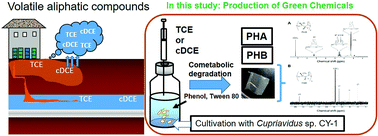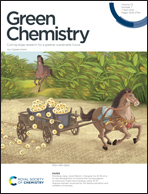Cometabolic degradation of toxic trichloroethene or cis-1,2-dichloroethene with phenol and production of poly-β-hydroxybutyrate (PHB)
Abstract
Trichloroethene (TCE) and cis-1,2-dichloroethene (cDCE) are volatile organic compounds (VOCs) that are ubiquitous in the environment and cause health concerns. In addition, the non-degradable nature of conventional plastics causes many environmental problems. Therefore, it is necessary to identify the bacteria that can degrade the toxic VOCs and convert them into biodegradable plastics. In this study, we used the bacteria Cupriavidus sp. CY-1 to degrade VOCs and produce biodegradable plastics, i.e., poly-β-hydroxybutyrate (PHB). The strain CY-1 showed growth when it was supplemented with TCE or cDCE along with the co-substrates phenol or Tween 80. TCE was co-oxidized and degraded into CO2, and the phenol degradation produced two metabolites, catechol and the fission products of catechol. TCE or cDCE was converted into PHB by CY-1 when supplemented with phenol. CY-1 showed the highest cell dry mass (CDM) when it was grown with cDCE (0.74 ± 0.09 g L−1) or TCE (0.68 ± 0.04 g L−1) along with phenol and Tween 80. CY-1 showed the highest PHB accumulation (350 ± 15 mg g−1 CDM) when it was incubated with cDCE, phenol and Tween 80. PHB production was calculated based on the bacterial CDM and high-pressure liquid chromatography results. FT-IR, 1H and 13C NMR analyses were conducted to identify PHB. The thermal properties of PHB were confirmed, using thermogravimetric and differential scanning calorimetry analysis. The chemical shifts of PHB produced from VOCs nearly matched with standard PHB; therefore, CY-1 could convert toxic VOCs into valuable chemicals such as PHB.



 Please wait while we load your content...
Please wait while we load your content...